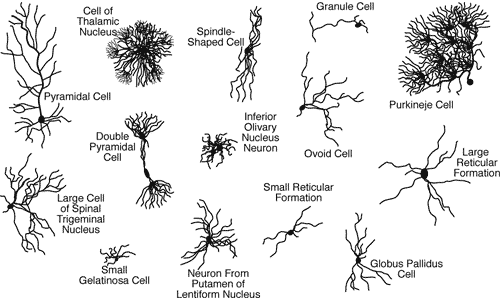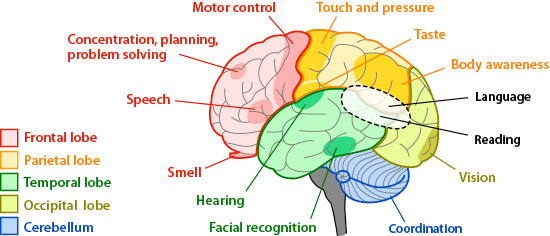This topic:¶
- Neurons in the brain
- The artificial neuron model
- Models of the brain
Reading:
- en.wikiversity.org/wiki/Fundamentals_of_Neuroscience
- Blumenfeld, "Neuroanatomy through clinical cases, 2e", 2010
- Geron Chapter 10 (Artificial Neural Networks)
Outcomes¶
- Point out key differences between biological and artificial neural networks
- Introduction to key biological ideas seen in artificial neural networks
I. Neuroscience¶
The Nervous System¶
- sensory signals in to brain
- motor signals out from brain
- to muscles
- to organs & glands
- intermediate processing at ganglia
- reflexes
- other simple tasks
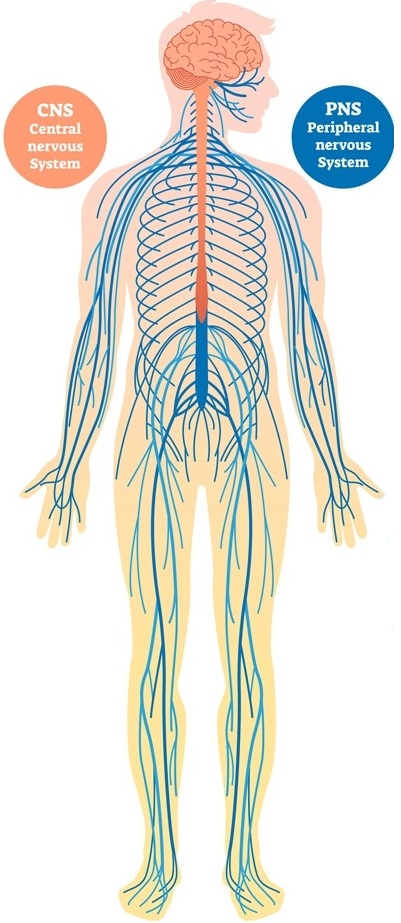
Gray matter and White matter¶
- Grey matter = cell bodies - think of as processing function step
- White matter = axons - connections, tons of them
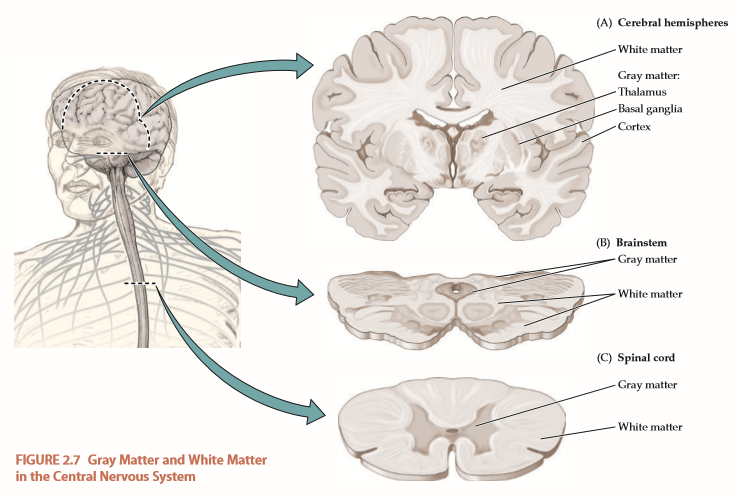
Diffusion weighted MRI¶
White matter in the brain is densely-packed with long-range connections between/among cortical regions and others
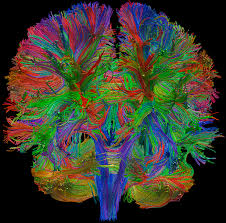
Biological Neurons¶
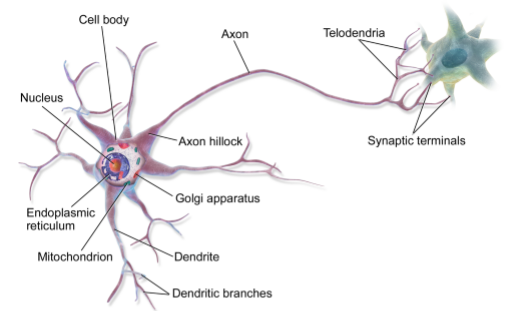
- cell body containing the nucleus and most of the cell’s complex components,
- many branching extensions called dendrites,
- plus one very long extension called the axon. The axon’s length may be just a few times longer than the cell body, or up to tens of thousands of times longer.
- Near its extremity the axon splits off into many branches called telodendria,
- at the tip of these branches are minuscule structures called synaptic terminals (or simply synapses), which are connected to the dendrites (or directly to the cell body) of other neurons.
- Biological neurons receive short electrical impulses called signals from other neurons via these synapses.
- When a neuron receives a sufficient number of signals from other neurons within a few milliseconds, it fires its own signals.
Neuron schematic¶
A neuron is a cell with a special cell membrane
- reshaped to produce interconnections
- covered in ion channels which can be controlled to produce/carry action potentials
- attach to other neurons with various kinds of synapses
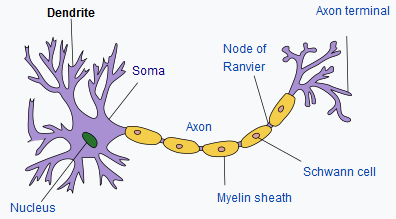
Neuron model¶
- ion channels
- membrane potential
- action potential ("spike")
- synapses
Action potential¶
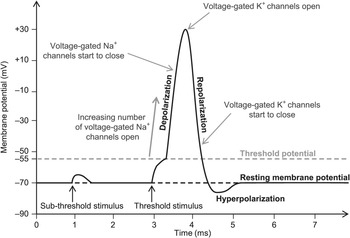
Info transfer via action potentials¶
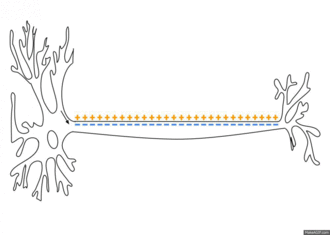
Neuron doctrine¶
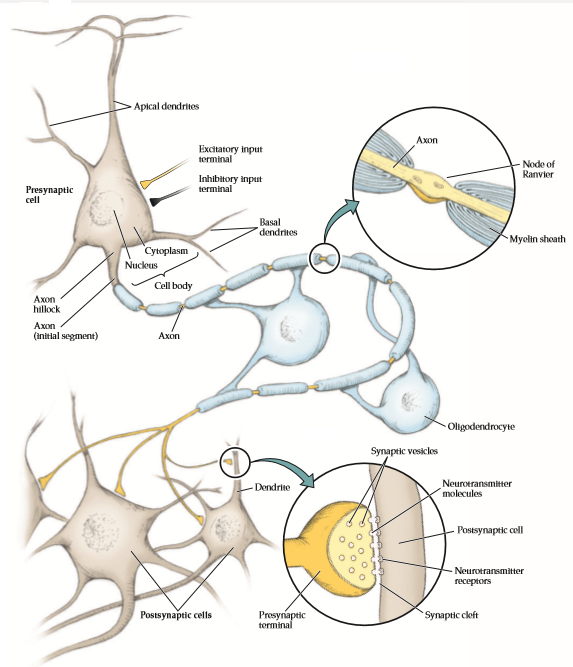
- The brain is composed of neurons (and other cells) that are independent structurally, metabolically and functionally.
- Information is transmitted from cell to cell across synapses
Synapses¶
There are a variety of different types of synapses which use different neurotransmitters.
The presynaptic neuro dumps neurotransmitter into the synaptic cleft (for most types of synapses)
The postsynaptic neuron has receptors to which the neurotransmitters (and other drugs present) may bind and cause change in potential.
- Excitatory - increase membrane potential of post-synaptic neuron
- Inhibitory - decrease membrane potential of post-synaptic neuron
Psychoactive drugs typically affect particular synapses at particular receptors, e.g. domaminergic (domamine), nicotinergic (affected by nicotene).
Hebbian Learning¶
"Neurons that fire together wire together"
Synapse between neurons is strenthened if they activate at same time
The Neuron - simplified mathematical model¶

Numbers representing input membrane potentials
Activation function represents threshold for spiking
Output number represents spike frequency
The Neuron as an algorithm¶

What is the mathematical function the artificial neuron computes?
Write code for a simple artificial neuron's behavior.
Networks of Neurons¶
- Individual biological neurons seem to behave in a rather simple way,
- But they are organized in a vast network of billions of neurons,
- Each neuron typically connected to thousands of other neurons.
- Highly complex computations can be performed by a vast network of fairly simple neurons
- The architecture of biological neural networks "BNN"s is still the subject of active research
- some parts of the brain have been mapped, and it seems that neurons are often organized in consecutive layers
Cross-section of cortical layers:

Neuron categories¶
- Motor neurons - attach to and provide signals to drive muscles
- Sensory neurons - return sensory signals to nervous system
- Interneurons - connect neurons to other neurons for intermediate processing steps.
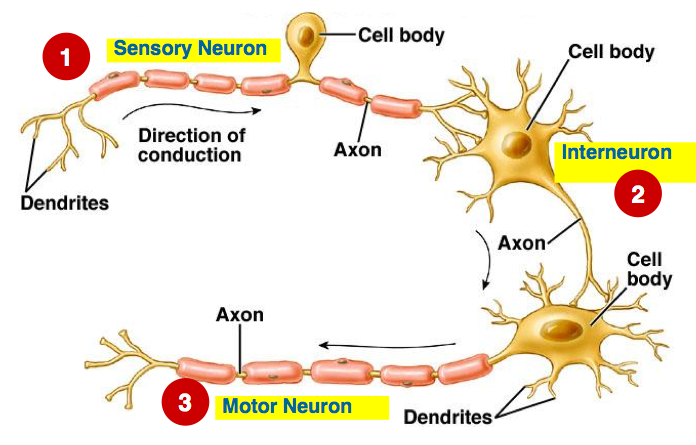
Example: reflex circuit - sensory signal activates muscle
Brodmann's cytoarchitectural areas¶
Regions of the brain can be differentiated based on cell types present
Also from neurology, we know different regions are important/necessary for different functions
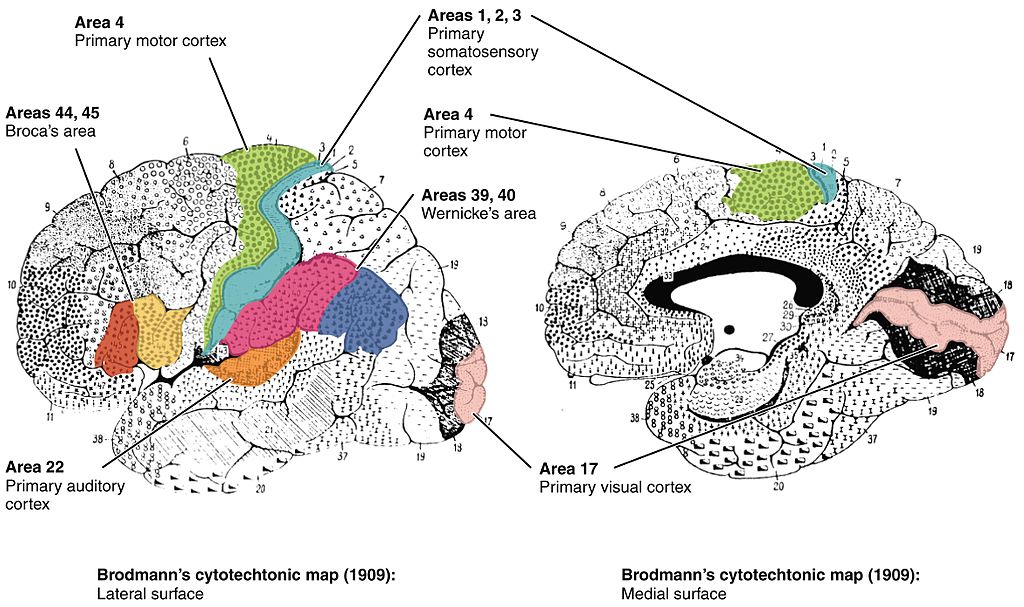
Vision pathways¶
- Retinal cells (rods & cones) respond to light.
- (retinal) Bipolar cells receive connections from one or more retinal cells
- Ganglion cells receive connections from one or more bipolar cells (LGN = lateral geniculate nucleus of thalamus)
- V1 (primary visual cotext) cells receive connections from LGN
- "What" pathway - IT = inferiotemporal area
- "Where" pathway - MT = medial temporal area
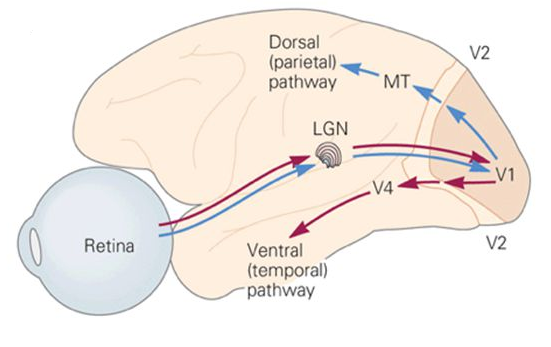
Note there are multiple "color channels" as well
Caveat about complexity¶
Many different pathways, processing color, motion, "blind sight", eye & pupil reflexes
Most connections are reciprocal (feedback and feed-forward)
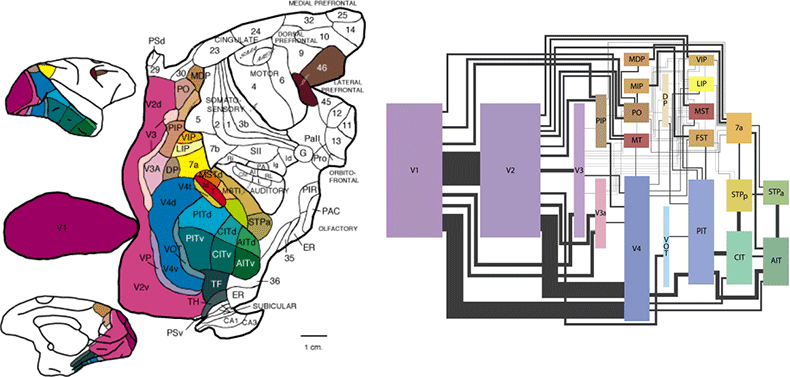
Briggs 2017, "Mammalian Visual System Organization", Oxford Research Encyclopedia
Receptive Fields - Bipolar cells¶
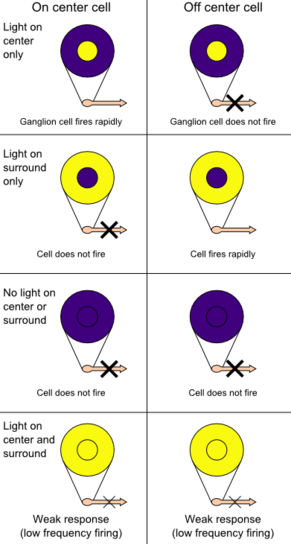
Draw the network of a single LGN cell that achieves this, and suggest connection strengths
Receptive fields - Simple cells (V1)¶
Hubel & Wiesel
https://goodpsychology.wordpress.com/2013/03/13/235/
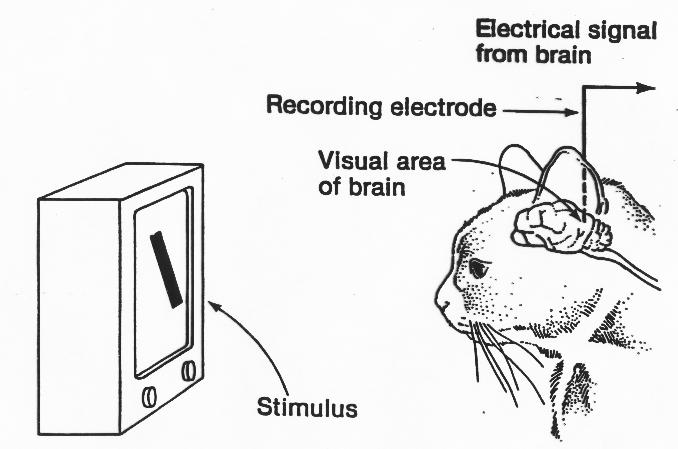
Receptive fields - Simple cells (V1)¶
Multiple ganglion cells synapse onto Single simple cell
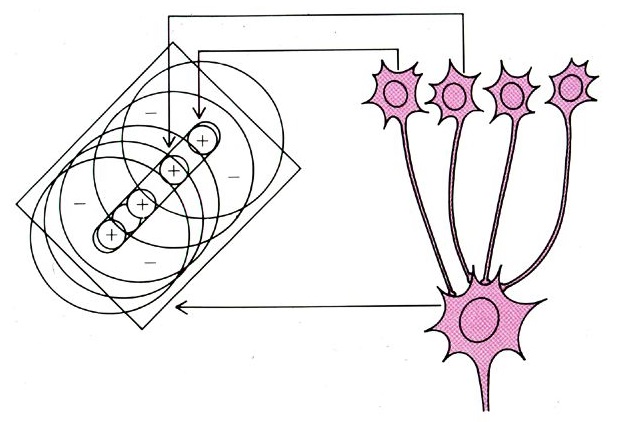
Draw the full network for this from inputs at retinal receptors
Deep neural network for vision¶
With increasing depth in brain, get increasingly-specialized receptive fields
Consider the what pathway, deeper neurons fire in response to complex stimulii
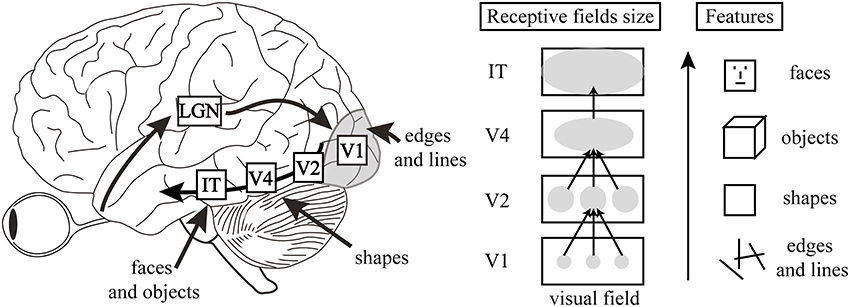
Primary & association cortex¶
Primary sensory cortex = first stop for information from senses
Association cortex = complex processing, combination of sensory information
Note motor cortex has similar divisions, but in opposite direction
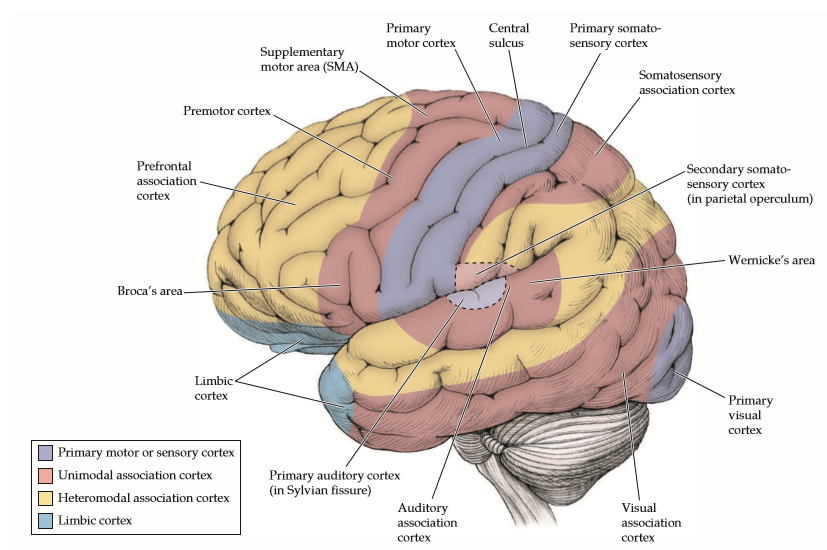
Motor system¶
- Consider the network underlying this model.
- What might individual neurons at each stage do?
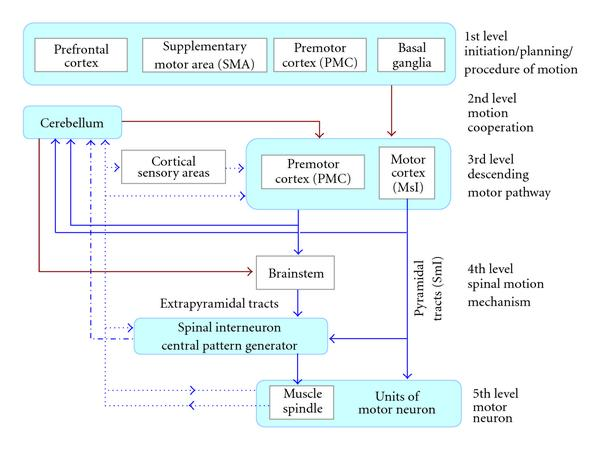
Satoshi et al, "Human Control Law and Brain Activity of Voluntary Motion by Utilizing a Balancing Task with an Inverted Pendulum", 2010
Parallel Sensory & Motor Hierarchies¶
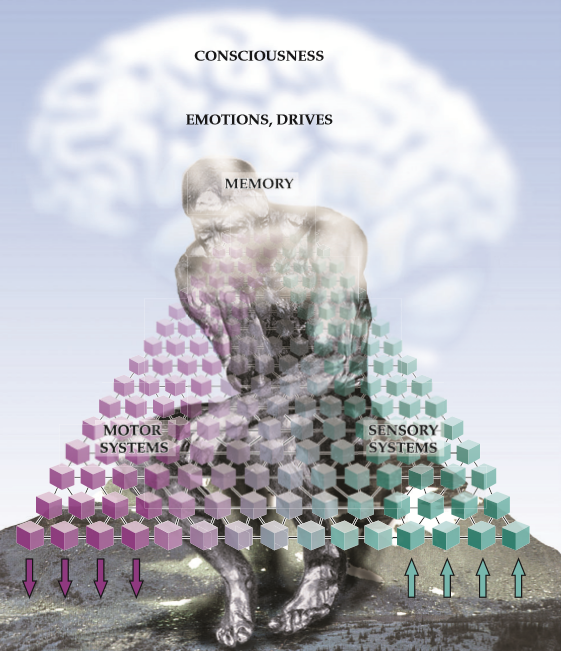
Memory system¶
Short term memory as a feedback loop that maintains information over time
Attention¶
Attention as a gain adjustment, possibly via feedback, that weights certain inputs more.

